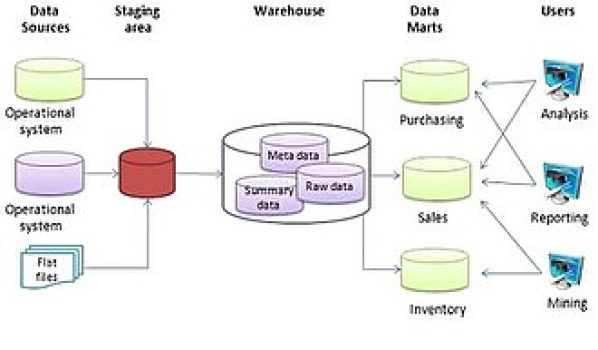Organizations have a few options when it comes to systems on which to base their data analytics stack.
Data managers might consider a centralized data warehouse, a series of data marts, or a combination of the two. So what’s the difference between a data mart and a data warehouse?
A data warehouse is a collection of all of an organization’s current and historical data from various sources into a single, consistent data source. On the other hand, a data mart is often a subset of a data warehouse that stores a single line of related data.
What we cover
What is Data Mart?
A data mart is a subject-oriented database that is often a partitioned segment of a data warehouse.
The subset of data stored in a data mart usually aligns with a certain aspect of the organization eg. finance, sales, or marketing.
A data mart accelerates an organization’s processes by giving them access to warehouse or operational data within days, instead of weeks. Since data marts focus on one aspect of the business, they are a cost-effective way to get business insights.
Data marts also focus on a single line of business holding very little data (typically under 100GB.) This leads to less clutter and makes them easier to maintain.
Types of Data Marts
There are three types of data marts based on their relationships to data warehouses and the respective sources of their data:
- Dependent data marts: These are partitioned segments within a data warehouse. This top-down approach begins with the storage of all processed data in a central location. The data marts then extract a defined subset of data from that primary source when needed.
- Independent data marts: These act as standalone systems that don’t rely on warehouses. Analysts can extract data on particular business processes from internal or external sources and store it in the data mart directly.
- Hybrid data marts: A hybrid data mart combines data from existing data warehouses with data from other operational systems. It integrates the speed and end-user focus achieved with a top-down approach with the benefits of extracting data directly from internal and external sources.
An example of a data mart use case is when a business wants to focus on market analysis and reporting.
Since these activities are performed in a specialized unit, the business can form a data mart to hold their databases, separate from other business operations, making them more accessible and easier to analyze.
What is a Data Warehouse?
A data warehouse is a large repository that stores all of an organization’s current and historical data from various sources into a single, consistent data source.
Data warehouses are used to support data mining, artificial intelligence, and machine learning, which can ultimately improve business intelligence.
Data warehouse solutions use a strategic collection process to consolidate operational data from different sources and make it available in one, united form.
For example, a business could create a comprehensive customer profile that combines retail data from different channels. By modeling and integrating this data, data analysts can help employees in various departments work out how best to relate with customers.
Similarities Between Data Mart and Data Warehouse
There are several similarities between data warehouses and data marts. Below are a few of the major ones.
Storing Processed Data
There are two primary forms of data: raw and processed. Raw data refers to data that has not been changed since acquisition.
On the other hand, processed data is data that has gone through some form of cleaning, transformation, or sorting.
Data marts and data warehouses store processed and filtered data with premeditated use.
Limited Accessibility
Accessibility refers to the ability to change the data within a repository. The data in data marts and data warehouses is already processed and refined.
It’s therefore more difficult to change, as opposed to unprocessed data such as in a data lake.
Support Cloud-Based Solutions
In the Big Data reality, most data warehouses are migrating to the cloud. Since data marts are mostly segments of data warehouses, cloud-based platforms are giving businesses the chance to have all their data marts in the cloud.
This not only lowers the operational costs of holding the data warehouses and data marts locally but also gives employees unhindered, real-time data access.
Differences Between Data Mart and Data Warehouse
While data marts and data warehouses are similar in some ways, they’re pretty different in others.
Here are some of the biggest differences between data marts and data warehouses:
Usage
Data warehouses are used to make strategic business decisions.
For instance, a business can create a data warehouse comprising customer data such as marketing campaigns, CRM records, and social media data.It can then analyze this data to improve its interactions with customers.
On the other hand, data marts are used to make tactical decisions. For example, if a marketing manufacturing manager wanted to analyze production delays, they can go to the production line data mart.
They can then query the data and run reports to determine where the fault lies. This analysis can be extracted quickly because of the limited scope and size of the data.
Types of Data They Handle
When it comes to the data type, Data warehouses are expansive and hold all types of data. Further, the data stored in data warehouses is more detailed.
On the other hand, data marts are built for specific user groups. Therefore, the data they handle is short and limited.
Scope
Data marts contain data from specific a department in an organization. There may be different data marts for finance, sales, marketing, etc. As a result, the data has limited usage.
In contrast, data warehouses are more helpful because they can bring data from any department.
Data Sources
As we’ve already established, data from data warehouses comes from multiple sources. This can be data from internal processes or even external data related to business operations.
Data marts, on the other hand, get their data from very free sources, often one department in the organization.
Processing Speed
Data marts have a higher processing speed because they deal with smaller, specialized subsets of data.
On the contrary, data warehouses have a slower processing speed because they deal with massive loads of unrelated data.
Size Comparison
Size in this case refers to the amount of storage each repository requires. Data marts are small in size because they store a limited amount of related data. Typically, a data mart is less than 100GB in size.
Data warehouses are much larger in comparison. They store massive loads of unrelated data and are more than 100GB in size by default. The higher storage requirements make them more costly to maintain.
Additionally, they require more computing power to process huge amounts of unrelated data. This drives the maintenance costs even higher.
Data Handling Capabilities
Data marts are made up of a single line of data. Therefore, they have limited data handling capabilities.
Data warehouses process much more data from different sources, giving them better data handling capabilities.
Designing and Implementation Process
Data marts can only handle small amounts of data and do little processing. As a result, they’re easy to design and implement. Typically, implementing a data mart takes a few days to a few weeks.
In addition, data marts can be spun quite easily because their designs are simple and similar.
On the other hand, data warehouses process much more data, which makes them more complicated to design and implement. It can take years for a data warehouse to be fully implemented.
Collecting the necessary data, gathering permissions, and storing it in a way that different users from the organization can access it takes time. Further, since data warehouse designs are complicated, it’s not easy to spin them around.
Flexibility
Data marts are restrictive because they are often project-based and exist for a short time. Data warehouses are more flexible because they are information-oriented and store data for a long time.
Lifespan
Data marts last for a short time and mostly end with the completion of a project. Data warehouses, on the other hand, last longer because they are information-oriented and hold historical data.
Security
An interesting capability of data marts is sectioning off specific data from users who wouldn’t be interested in it or, more importantly, shouldn’t access it.
For instance, a data warehouse might include salary or employee retention information, which shouldn’t be accessible to all employees. This sensitive information can be separated by creating dedicated data marts.
While a good database administrator can apply security rules to a data warehouse to protect such data, it’s more secure to remove all access through a data mart.
Advantages and Disadvantages Summary
| Data marts | Data warehouses | ||
| Pros | Cons | Pros | Cons |
| Used to make tactical decisions | Have a short lifespan | Used to make strategic decisions | Difficult to design and implement |
| Organize processed data from one line of the business | More restrictive than data warehouses | Have a long lifespan | Slow processing speeds |
| High processing speed | Little data handling capabilities | Have high data processing capabilities | Expensive to maintain |
| Smaller in size | Have high data handling capabilities | ||
| Require little computing power | More flexible than data marts | ||
| Cheap to maintain | Can contain several data marts | ||
| Easy to design and implement | Process data from different sources |
Which Is Better For You?
Since data marts and data warehouses have different objectives, it’s never an “either, or” situation.
Data warehouses can address high-level business decisions. They store historical and current data from multiple disparate sources. This makes them a single source of truth for a data-driven organization.
Data marts are excellent for tactical, department-specific analysis. They are easy to use, design, and implement. As a result, each that department requires these types of analytic capabilities needs its own data mart.
To sum it up, both data marts and data warehouses have their use cases. It’s therefore up to the organization to decide which one they need at a particular time.
And, since a data mart is a subset of a data warehouse, it’s possible to have both repositories in the organization.
Why Would a Company Invest in One Over the Other?
A data mart can accelerate business processes by allowing access to relevant information within days, as opposed to the months it would take with a data warehouse.
Therefore, if a company wanted to analyze a specific aspect of the organization, say finance, it would be faster and more effective to use a data mart instead of a data warehouse.






